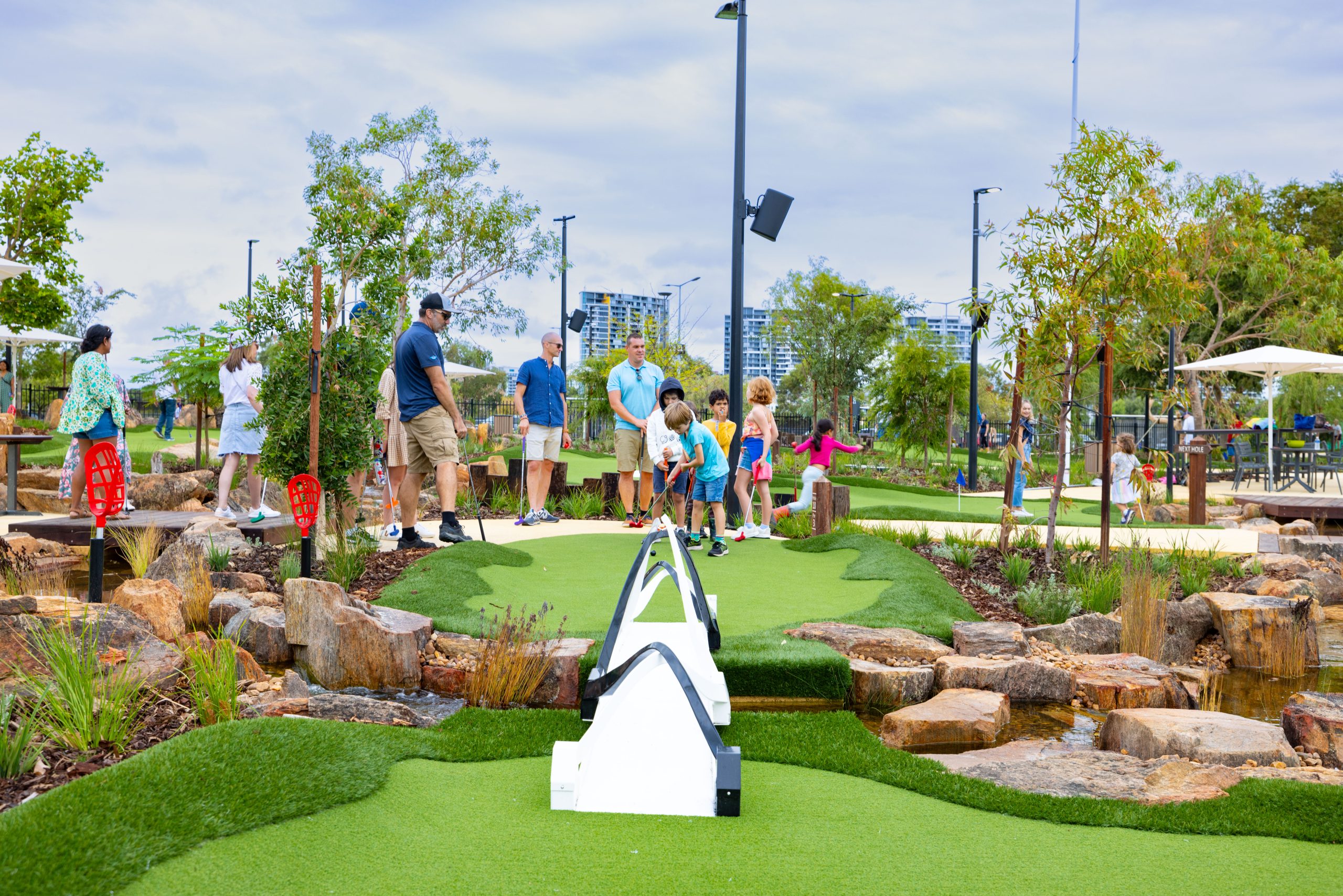History of Matagarup
MATTA GERUP (MATAGARUP)
The area of mudflats and wetlands of today’s Burswood Peninsula have been known for tens of thousands of years as Matta Gerup by the local Whadjuk Nyungar people. Translated to English, Matta Gerup means ‘knee deep’ and refers to the shallow waters found at the site of the present Causeway. Originally a broad area of mudflats, islets, swamps and shallow lakes, this area in Beeloo Munday’s territory provided ideal hunting and fishing grounds and the yanjidee, or bulrushes, found throughout the river area yielded edible roots dug up by Nyungar women in the season of Djeran (April-May).
According to Museum of Perth exhibition Gnarla Boodja Mili Mili (Our Country on Paper): “The site is an important part in the creation journey of the Waugyl, the giant rainbow snake of Noongar Dreaming. When the Waugyl tunnelled west towards the ocean, creating the bilya (Swan River), he became stuck in the mud flats and had to shake his scales off in the mud to get through to Buneenboro (Perth Water).”
Europeans visited and documented these mudflats from as early as January 1697 when members of Dutchman Willem de Vlamingh’s party inspected the river.
The French explorer Nicholas Baudin investigated the area in June 1801, naming the shallow island site after Francois-Antoine Boniface Heirisson, one of his expedition leaders.
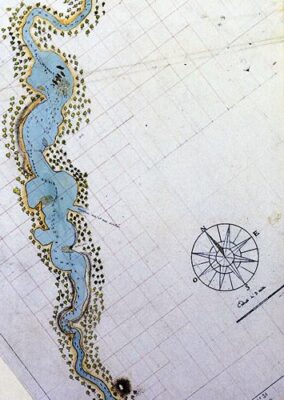 [Image to left: part of the Swan River Chart drawn by Heirisson showing the mudflat islands as a series of black marks. http://www.liswa.wa.gov.au/ treasures/freycinet/swan river.htm].
[Image to left: part of the Swan River Chart drawn by Heirisson showing the mudflat islands as a series of black marks. http://www.liswa.wa.gov.au/ treasures/freycinet/swan river.htm].
Englishman Captain James Stirling viewed the site in March 1827, moving through the islets with difficulty to gain access further up the river. His later recollections of the journey stated: “March 9: From daylight on the 9th until dark the party struggled with the boats on the mudflats at Burrswood.” However, Stirling’s enthusiasm for what he had seen was part of what convinced the British government to send Stirling back to the location in June 1829 with soldiers and two shiploads of settlers and, to the dismay of the local Indigenous people, instigate the Swan River Colony on the banks of the river the Nyungars called Derbal Yaragan.
To this day Matagarup remains an important place of spiritual and cultural significance to the Whadjuk Nyungar people.

Henry Camfield was a young Englishman who arrived in the new colony on 12 October 1829 aboard the ship Caroline. He brought with him £600 and two indentured servants, Richard Smith and Frederick Friend along with their families. The value of Camfield’s contribution to the colony entitled him to a land grant of 7,000 acres under the British settlement system. After an investigative tour up the river inspecting the nature of the soils with Colonial Secretary, Peter Broun, Camfield opted for 1,000 acres of land in the mudflat, wetland area Matta Gerup, close to the site of the town settlement of Perth, and a further grant on the Helena River, later named Clayton. Inspired by the luxuriant grasslands he had viewed, Camfield was not to know that the large, open, almost-treeless expanses, had been carefully cultivated by the Nyungar people, creating perfect areas for the hunting of kangaroo. Oblivious to his unwanted intrusion, Camfield named his property “Burrswood,” after his father’s farm in Groombridge, Kent, in the south-east of England.
Camfield was an experienced farmer and expert hop grower and the marshy land of the river wetlands provided plenty of fresh water and rich soil ideal for cultivation. His carpenter Richard Smith began work on the wattle and daub huts that would house them and although initial crops failed until local knowledge of the seasons and weather was gained, in a relatively short time Camfield had a large garden and highly productive fruit trees. He was also soon growing wheat, oats, barley, Indian corn, mangels (a large coarse type of beet grown primarily as cattle feed), millet, lucerne and by the mid-1840s he had planted 300 grape vines.
Navigating the mudflat area could be treacherous and the cost of getting goods from Fremantle to Burrswood was expensive at £3 per day for a boat carrying three tons. It could also take “five or six days. Then you must either carry them by land until you pass the sands, or build a float, which most of us are doing.” Having two good workmen, Camfield used his carpenter, Smith, to make flat-bottomed boats for himself and others, while he and Frederick Friend busied themselves getting goods as far as Perth.
A tragedy befell the group when on 4 January 1831, Friend was drowned in a boating accident trying to get their goods from Fremantle. Camfield reported: “I was stooping in the stern baling out the water. In Rocky Bay we broke our mast. At a place called Rushy Point just below Point Walter, Friend, who was smiling on the starboard gunwale steering with an oar, must have made a false pull, and thus fell overboard. The moment I was aware of it I let go the sheet, but the sea breeze was blowing strongly and the flat made such way he could not overtake it. Finding this impossible, he tried to make the shore but could not. Imagine my miserable, my unhappy situation. I have lost a valuable servant and miss him very much.”
Frederick’s widow Frances and her children, Mary Ann and young Frederick George born on the journey out, were not long alone. Richard Barndon had also arrived aboard the Caroline as an employee of the Henty brothers, who were related to Camfield by the marriage of his sister to their brother William. Barndon courted Mrs Friend, visiting her fortnightly, leading to their marriage on 16 September 1831. Prior to this time Camfield had founded an inn on his property while enduring failing crops. He wrote to his family “I have opened a public house to keep body and soul together; people must not be particular. Mrs Friend is my bar woman…” Camfield leased Burrswood to Barndon and for some time the land and the inn became known as Barndon’s instead of Burrswood.
As Camfield’s crops began to prosper so did his authority and standing in the colony. He married Annie Breeze on 19 December, 1840, the first couple to be married in the original Octagon Church at Middle Swan. Just before his marriage Camfield advertised his property to let for 1, 2 or 3 years. With his property taken care of and marriage established Camfield focussed on his career with the government. He was appointed Collector of Colonial Revenue in 1842, Postmaster General in 1845 and then moved to Albany to take up the position of Resident Magistrate in 1848 and was associated with the Albany Convict Depot from 1851 after Western Australia was promulgated a penal colony in 1850. He and his wife ran the Native Mission and School at Albany from 1852 until 1871, a year before Camfield’s death.
In the meantime, on Burrswood, Barndon’s Inn continued to operate until at least 1843 and the hill travelled up on the road between Perth and Guildford, near the later Burswood Railway Station, became known as Barndon’s Hill. In 1844 Camfield was again advertising cottages on Burrswood to let together with stock and warning off people trespassing to cut wood. The property passed out of Camfield’s ownership when it was sold in May 1855 to the Colonial Surgeon, Dr John Ferguson. From this time the property was called Burswood Island.
Dr John Ferguson purchased Burswood Island in May 1855 for £1000, £1 per acre. In 1856 Ferguson was having issues with duck-shooters visiting the island and lighting fires and he advertised that only those with written permission to be on the land would be permitted, others would be prosecuted. In 1858, Ferguson advertised Burswood Island to let with 60 acres of cleared land for farming and garden produce. A series of lessees followed. Discharged former 96th Regiment Private William Elsegood was living on Burswood Island in 1862, the property then known as Burswood Farm. In 1870, publican of the Shamrock Hotel, James Ougden, was living on Burswood Island. Pronounced insolvent, his property was to be sold off at the location of Burswood Farm. A blacksmith in the 1860s, Ougden had intended to purchase Burswood Island before running into debt. The following year he was leasing a coach run between Perth and Bunbury when he died after falling from his horse and sustaining fatal injuries.
Receiving yet another name change, Burswood was identified as Bishop’s Island when it was once more advertised to let with a six-roomed cottage in March 1873 by Edmund Birch and his business partner George Randell, both prominently associated with Perth’s Congregational Church. Around the mid-1870s ownership of the island passed to Francis Von Bibra, son of Franconian aristocrat Franz Ludwig Von Bibra who had close associations with the British Royal Family. Von Bibra expanded his wealth in Western Australia with interests in grazing, shipping and pearling. Taking ownership of the island around 1875, by August 1876 Von Bibra had established a dairy on the island and was taking orders as well as trading from a milk cart opposite the Town Hall selling to the public between the hours of 7-8am and 5-6pm daily. Von Bibra offered 800 acres of the Burswood Estate for sale for £3000 in November 1885.
Hugh Bresland was running the dairy farm on Burswood Island in 1886, and in February 1887 the Splendid Dairy Farm, part of Swan Location 35, known as Burswood or Bibra’s Island, was advertised to let. In October 1888 the freehold of part of Swan Location 35, 470 acres of Burswood or Bishop’s Island, was offered for sale. Teetotaller Bresland kindly allowed the island to be used for the annual Presbyterian Church Sunday School picnic which attracted 300 attendees in February 1889.
In 1890 Albert Clerk advertised to Stock Owners that “The famous paddocks at ‘Burswood’ Bishops’ Island, are now in my hands and I am prepared to make terms for the agistment of stock of all kinds.Arrangements must be made personally with me. ALBERT CLERK. Perth Horse Bazaar.” A change for Burswood’s future was mooted in early 1890 when it began to be considered as a potential site for a sewage disposal scheme.
Upriver, Guildford was quickly overtaking Perth in prominence as the furthest navigable point on the Swan River and the closest point of contact for the country districts. It was the location Governor James Stirling chose to build his home and was the centre of society in early days of the colony. Guildford became an inland port and with the mudflats of Matta Gerup proving obstructive, in 1831 canal works cut through Henry Camfield’s land grant effectively creating Burrswood Island. The first effort was declared ‘useless’ by Camfield and further work was required. The Government called for tenders in February 1833 for a contractor to build dikes “To block up the Channels between the Islands beginning from the first, from the Canal, with a double stake and a wattled fence filled in with clay.”
In November of that year a report provided by committee members James Drummond, Micheal Clarkson and Joseph Hardy who had been appointed by the Agricultural Society of Western Australia for “examining the Flats, with a view to improve the Navigation across them,” suggested for Burrswood that “the next 12 chains will cross the S. W. point of Mr. Camfield’s location, which consists of low land, covered with rushes and samphire, which, with the earth should be removed to form part of the Bank across the Flats.” Several recommendations were given and the report concluded: “That the lower Bank of the Canal will be sufficient road for foot and horse passengers going from the country to Perth, which, by this great improvement, will be only about two miles from Hancocks Inn. That, provided good workmen can be had at 5s. per day, their wages, till the completion of the work, will not exceed Four hundred Pounds.” Further canal works were carried out in 1834 and 1839.
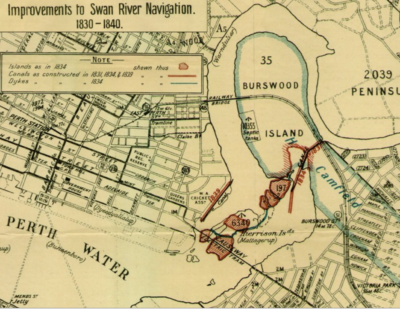
It has formerly been believed that the name of Burrswood, initially given by Henry Camfield in homage to his family property in England, was changed with an incorrect spelling of the name as Burswood in 1893 by a painter preparing the sign for the first railway station in the area. The property however was already being advertised in the newspapers as Burswood with one R as early as May 1855 when the estate changed hands, sold by Henry Camfield to Colonial Surgeon, Dr John Ferguson.
When the Burswood railway station opened in 1893 it presented attractive opportunities for the surrounding area. Land adjacent was purchased and the newly developed Riversdale Estate was marketed in glowing terms. As the train could also deliver large numbers of people to the previously relatively isolated location, it became possible for future ventures such as the Perth Golf Club and the Belmont Racecourse to be established.
The name of the estate was renamed Rivervale and the Burswood train station was later renamed Rivervale station in 1923 in response to stigma relating to the sewage disposal works on the Island. The opening of the Burswood Island Casino in 1985 brought renewed status to the area and the locals opted to have the station renamed Burswood.
As early as 1864 a newspaper correspondent lamented the lack of entertainment to be had in Perth asking “Why do not the working-men get up quoit clubs and skittle clubs? or play at foot-ball, or golf? The want of amusement is one of the principal drawbacks to this place.” At this time golf was primarily played in Scotland but its migration further afield was noted in Perth newspapers in 1889: “The game of golf has come South from Scotland, and forms the latest popular amusement in England. It is specially popular in London forming an interesting game giving exercise without too great fatigue, and is much played by middle aged city men.”
The game was slowly gaining attention in Western Australia so when the Victorians formed a club to play the game of golf in 1891 and shortly thereafter flocked in their thousands to the newly-discovered Western Australian goldfields, the scene was set. While some were concerned that the new game could come to rival “our national sport” of cricket in popularity, both being viewed as leisurely gentlemen’s games, others enthused over the chief appeal of golf as being playable year-round by people of all ages in all weather conditions. With a relatively small initial outlay to set up a course and keep it running, the onus was then on the player to provide their own equipment, so keeping costs low. The booming gold period saw Perth’s golfing enthusiasts meet in the Government House ballroom in August 1895 to discuss forming a club and acquiring appropriate land to develop a golf course. Burswood Island was chosen as the ideal location and a nine-hole course was laid out.
Quick off the mark, sporting goods purveyor, E. S. Wigg and Son in Hay Street Perth advertised, “E S. WIGG & Son have just unpacked a shipment of Golfing Material, including – Putters, Drivers, Cleeks, Tees, Balls, Scoring Cards, and everything necessary to start the Ancient Game.”
The newly formed Perth Golf Club officially opened on Saturday 5 October 1895, the first game being played at 3.30pm that day. The list of its founding members read like a Who’s Who of the upper echelons of Perth society including Sir Alexander Onslow (W.A. Chief Justice) as President and with Vice-Presidents, Mr Edward. H. Wittenoom, M.L.C., Mr. George Leake (future Premier of Western Australia), Leake’s son-in-law Mr Stephen H. Parker, M.L.C., and Mr F. T. C. Faulkner (Headmaster of Hale School).
Perth’s first golf course on Burswood Island was quickly to outgrow its location. Difficulties in transit to and from the location were cited, initially being accessible only by boat, as well as the rough farmland terrain and often damp conditions under foot making it difficult to score well. Four years later in 1899 a horse racing course was also established on the island. A new 9-hole golf course was developed in 1900 at Wattle Grove Farm in Belmont, alongside the race course, and golfers were often interrupted in their game having to pause to allow galloping horses to pass by. Proximity to the river causing wet playing conditions finally lead to the Perth Golf Club moving again, eight years later, to South Perth.
Albert Cockram became a wealthy horse owner and investor who would have been well-acquainted with Burswood Island owner and horse bazaar operator Albert Clerk in the early 1890s. Cockram initially leased 431 acres on Burswood Island where he had begun running the dairy at Barndon Hill from 1892 with his brother-in-law and business partner, James Carmichael. He is thought to have purchased Burswood Island for £25,000 around the mid-1890s. He built the Belmont and later the Goodwood Racecourses and was their last private owner.
In choosing to set up his own race course at Burswood Island in 1899 Cockram began operating outside of the registration restrictions imposed by the W.A. Turf Club. Stipulated as a race course for ‘ponies’ rather than thoroughbred horses, the term broadly included ponies, hacks, trotters, and a Scottish breed known as galloways; while in reality any horse owner could enter their horse in races there. This move was ironic for Cockram who, although he bred station and farm stock of all descriptions, he specialised in breeding horses. He has been credited as being the first to bring thoroughbred horses to Western Australia and at one time the largest importer of thoroughbreds into Australia.
Five hundred people attended the inaugural race meeting of the unregistered Burswood Turf Club on Saturday 9 December 1899. Racing commenced at 3 pm, the programme comprising six races including the main event, fourth race of the day – the Burswood Cup. The race, run over a mile, had five starters and in an exciting finish, black gelding Pluto beat 6-year-old brown mare, Thelma, by a head, with third place getter Acrobat only three-parts of a length behind. The winning time was 1 minute, 47 seconds, with twenty sovereigns going to the winning owner, J. Dellar.
The unregistered pony racing clubs were viewed as lower class enterprises attracting people of an undesirable nature, including cheats, thieves, rogues and prostitutes. In 1900 Cockram took the Belmont course into the registered WATC fold, racing thoroughbreds, however he also set up Goodwood next door in 1912 to continue the pony racing. The difference between the two was seen to be that distinguishing the upper from the lower classes with the registered clubs charging more for entry, paying more for winners, running things on an official basis, attracting a higher class of clientele and putting funds back into the industry, as opposed to the pony racing courses being run more as a business and form of entertainment and spectacle, attracting those who had been banned from registered clubs for unscrupulous behaviour. Cockram hedged his bets and operated in both worlds.
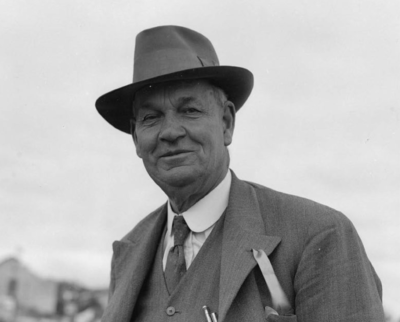
Cockram is acknowledged as being a pioneer in the development of the fledgling Western Australian turf racing industry and was an inaugural member of the W.A. Trotting Association. He had great success as an owner winning major races throughout Australia, including five Perth Cups and two Sydney Cups. In 1914, he was the only man in Australia to run a horse in the English Derby. In 1920 he was reported by the Sydney Morning Herald as being “unquestionably one of the best judges of stock in the Commonwealth”. It wasn’t until after Cockram’s death in 1943 that the WATC could consolidate all horse racing ventures and make registration mandatory. Today the Belmont Park racecourse remains one of Perth’s two major horse racing venues, the other being the Ascot Racecourse, also located on the Burswood Peninsula.
Urban sanitation was becoming an urgent health issue facing the city of Perth by early 1890 and a debate raged around the removal of night-soil to a location where it could be treated and the clean wastewater returned to the river. The treated sewage could then be utilised to irrigate and produce good garden soil from pure sand. It was proposed that a ‘Sewage Farm’ could be established on Burswood Island. A sub-committee of the Local Board of Health was appointed for the purpose of “deciding on a suitable locality for the deposit of city refuse with a view to the ultimate establishment of deep drainage and a permanent sewage farm.” The plan was reported as follows:
“Burswood, which the sub-committee recommend as the site for the sewage farm, is a small islet on the left of the Causeway, and lying opposite Victoria Park. The entire piece of ground is known as Location 35, and consists of 1,000 acres, but is divided into two parts by a canal. The piece opposite Victoria Park contains about 377 acres. It is proposed to obtain about two acres of Victoria Park, by the river, and to connect this with Burswood by means of a pipe. The pipe is to be sunk at a depth of not less than eight feet at the city end, and carried straight across the river, through the marshy shore and into the clayey ground of Burswood, where, owing to the pipe sloping downwards in that direction, whatever passed through it would flow into tanks, constructed to receive the flow. The distance, including the length of marshy, ground to be traversed, would not be much over 20 chains. At the city end of the pipe, a shoot would be constructed for the reception of the night-soil, and to keep it continually flushed a pump worked by wind-power and a couple of tanks would be erected there, the water being drawn from the river. The two acres would be enclosed with a fence, and the gates would be kept locked, each nightman being supplied with a key.
Burswood, as already stated, is to be the sewage farm, and the usual machinery for pumping the sewage from the tanks and distributing it over the land would be provided. The price asked by the owners of the land is £6,000, and Mr. Paterson stated that he thought the cost of the work itself would be about £1,000. The sub-committee strongly recommended the plan, urging that, if it were carried out, Claisebrook, which they consider the natural drain for the city, would be connected with the sewage farm, when the Municipality undertook to establish the deep-drainage system in Perth. They further point out the possibility of reclaiming the swamp lands adjoining the sewage farm, with a view, no doubt, to using them as gardens.”
Nothing happened initially, and, while parliament discussions about railways transporting sewage occurred in September 1895, it was in 1897 on the back of engineer Napier Bell’s report to Government that three serious options were considered. Burswood, in his considered opinion, was not a suitable site for sewage disposal without costly work on its largely clay soils. He stated that pure sand, “if properly drained, would easily purify the sewage of 600 persons per acre.” The soil of the chosen site of a sewage farm would be the chief factor determining the success of the venture. Mr Napier Bell’s report was considered and yet Perth continued to earn its reputation as one of the unhealthiest cities in Australia for its unsanitary conditions as parliament dithered over selecting an option.
Finally in 1906, land at Burswood began to be reclaimed from owner Albert Cockram to build the long-awaited sewage filtration beds. By May of that year a tender had been accepted by the government for the construction of the first portion of the metropolitan sewerage scheme. The West Australian reported on 4 June that “four septic-tanks are to be constructed in the public gardens reserve at Claisebrook, and that the effluent from these tanks will be conveyed across the river to a point on Burswood Island, where a battery of streaming filters will be situated, delivering the filtrate directly into the river.” The scheme was expected to cost £106,000 for main sewers, reticulation and installation of a bacterial plant. This was just one part of a wider scheme for the metropolitan area.
The scheme attracted criticism from its outset and by 1922 the “Burswood Blunders” were being constantly publicised highlighting air pollution issues from gas by-products of the process and toxic algal growth in the river. Burswood was considered a ‘stinkpot’ and described as a ‘running sore’. In 1934, after ongoing public dissent, the Minister for Works reported that the Government was going ahead with its proposal to abolish the Burswood filter beds.
Post-World War One the Western Australian government was addressing the dual concerns of providing employment for returned servicemen and fostering manufacturing. One important industry was the local production of cement. The 28-acre site at Burswood was considered ideal with easy access by rail, water and road as well as providing an abundance of clay. In April 1919 The West Australian reported the following:
“Lime and Cement Works.–The West Australian Portland Cement Company is now erecting its works for the manufacture of portland cement, agricultural lime and allied products. The company has a capital of £125,000 and it has secured the rights to the extensive deposits of carbonate of lime at Lake Clifton. A railway is being constructed from the lake to Waroona. The cement works are being erected at Burswood and the machinery, which will be the only part of the equipment not produced locally, will turn out 30,000 tons of cement annually. These works will give employment to about 150 men in the construction of the railway; between 50 and 60 in the building of the works, and over 60 men will be permanently employed.”
The company lost no time in installing the equipment to start operations but as early as October 1919 the trade union movement was involved in the workers’ cause, arguing for more than the 12 shillings per day the men were being paid. Trade Unionism had reached a zenith during the war period with strikes and industrial action causing great disruption to labour forces. The Australian Workers Union had through amalgamation become the strongest union in Australia and as post-war production and manufacturing accelerated in Western Australia so union activity increased. The cement workers were involved in an ongoing industrial dispute over wages for the first couple of years of the cement works’ operation and wages disputes were still occurring in 1926.
Previously depending on an Eastern States imported product, the cement works advertised its value to the local community:
W.A. PORTLAND CEMENT WORKS, AN ENTERPRISE THAT PROSPERED, Big Asset To The State
Story of Rapid Achievement
Few people fully appreciate the national significance of that large iron building, with its towering chimney stack, which overlooks the city from the river bank at Burswood. It is this works of the West Australian Portland Cement Co. Ltd. — a concern which, in spite of obstacles and discouragement, has securely established itself in the State, and is performing an incalculable service to the community.
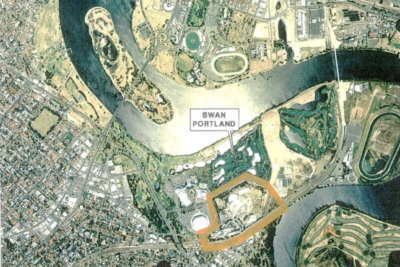 West Australian Portland Cement Co. Ltd, an operation run from New South Wales, was liquidated in 1927 and the Swan Portland Cement Company was registered. The works, site, plant and machinery were transferred to the new company along with a Government license to remove shell from the river.
West Australian Portland Cement Co. Ltd, an operation run from New South Wales, was liquidated in 1927 and the Swan Portland Cement Company was registered. The works, site, plant and machinery were transferred to the new company along with a Government license to remove shell from the river.
In August 1939, a company advertisement highlighted the perfect location on the Swan River in Rivervale as supplying two of the required ingredients in their cement as being locally dredged clay and decayed oyster shell, with limestone coming from Fremantle. By this time the company was producing 75 – 80,000 tons of cement annually and employing 180 people. The waste products being produced on the site included coal dust from the use of coal-powered kilns in which the coal first had to be dried and ground into a powder and cement dust from the storage and bagging processes.
The W.A. and later Swan Portland Cement Company operated for over seventy-five years on the Burswood site relocating to the industrial estate in Kwinana in 1997.
James Hardie and Co. Ltd, Sydney was claiming to have pioneered production of asbestos cement sheets and slates in Australia and to be the largest manufacturer in the southern hemisphere at the All-Australian Exhibition at Moore Park in October 1922. Their primary production sites were located at Camellia in New South Wales and Burswood in Western Australia.
 Co-located next to the cement works on Burswood Island, large steel mains pipes were being lined with concrete to combat interior corrosion and asbestos was being used to coat the outside of the pipes to give them longer life. The building product, asbestos cement sheets, were made of a mixture of asbestos and cement in a ratio of 1 to 9.
Co-located next to the cement works on Burswood Island, large steel mains pipes were being lined with concrete to combat interior corrosion and asbestos was being used to coat the outside of the pipes to give them longer life. The building product, asbestos cement sheets, were made of a mixture of asbestos and cement in a ratio of 1 to 9.
The versatile, tough and heat and moisture resistant sheets were ideal for both internal and external use in domestic, agricultural, commercial and industrial applications. The fibro cement sheets were widely used from the 1950s until 1981 when production at Burswood ceased once the harmful health effects of asbestos fibres became more widely recognised.
Already known for accommodating industries producing noxious, smelly and unpleasant conditions it seems only natural that the Burswood Island would also become a general and industrial waste disposal site. A decade after the sewage filtration beds ceased operation at Burswood the location became a rubbish tip. Already receiving fly ash from the East Perth Power Station on the opposite side of the river from 1946, in 1954 waste and rubbish from the surrounding area was also disposed of there. This practice continued until 1972 when it closed, being briefly reopened for general waste in 1978.
From 1979 garden waste and tree prunings were taken there for chipping, however the decision in 1984 to develop the land into the Burswood Island Resort and Casino meant an end to the practice. In 1985 the use of the site for waste disposal finally ended and an 18-hole golf course attached to the Burswood Island resort was developed there.
In the heady years of prosperity and WA-Inc of the 1980s, Perth businessman Dallas Dempster put the idea to the then Premier, Brian Burke, of building a casino and resort on the peninsula and landfill facility of Burswood Island. This suggestion became a reality when the WA government put the project out to tender in 1984. The entire venture included a casino, hotel, 18-hole golf course, restaurants, theatre, ballroom, convention and exhibition centre, tennis courts and a beautification of the surrounding parklands. The approval for development was passed by parliament in March 1985. The builder of the complex was Tileska Pty Ltd, a company in which Dempster was a partner. When it opened, it was the largest casino in Australia and third largest in the world.
In a period in Perth where the night scene was dominated by nightclubs and bars, the newly opened Burswood Island Casino became the place to go. With free entertainment and gaming tables as far as the eye could see, the smoke-filled casino was bulging with patrons and often had long queues of people waiting to get in.
Two years later the complex complemented its offerings with a unique sports and entertainment venue – the Burswood Superdome. The dome’s inflated fibreglass roof relied on an airlock system of entry to keep the dome from deflating. With the capacity to hold up to 20,000 people the venue hosted large-scale concerts and regular sporting events such as the Wildcats basketball games and the international Hopman Cup tennis tournament, held there every year from 1989 to 2012. The Burswood Dome’s number was up when the new sporting and entertainment complex the Perth Arena was built in the city on the site of the demolished Perth Entertainment Centre. The Wildcats made the Perth Arena their new home and when the final Hopman Cup tennis tournament was held at the Dome in 2012 moving to the Perth Arena in 2013, the Burswood Dome was demolished shortly thereafter. Work to develop a new sporting stadium was to shortly begin further down the peninsula.
With the development of the casino complex the surrounding lands were developed into extensive public parklands and recreational facilities which come under the authority of the Burswood Park Board, a Western Australian Government statutory body. The 56-acre parklands are freely available to host public events and are used for events such as concerts, markets, fairs, car rallies, night-time charity cinemas during Summer and exercise groups such as yoga, cycling, walking and running. There is also an historic heritage trail including sculptures and statues.
Making use of the beautiful Swan River, members of the Western Australian Recreational Water Sports Association have their home at the Burswood Watersports Centre including the W.A. Water Ski Association, the W.A. Speed Boat Club, the Boating Industry Association of W.A., the Power Dinghy Racing Club as well as the West Australian Marathon Club (competitive and social running). It is also home to the State Tennis Centre.
Perth waited with bated breath in January 2018 for the official opening of its newest and largest-ever sporting and special events stadium which had been under construction for the past several years. Although the first international sporting event had already been held there in December 2017 with the Perth Scorchers Twenty20 cricket team playing in an international friendly match against the England Lions, 18 January loomed large in the imagination of excited Perth locals who were able to obtain free tickets for an open-day to view the new facility and see what almost $2 billion of tax-payers money had been spent on.
Naming rights given to telecom company Optus, the new Optus Stadium is located at the northern most point of the Burswood peninsula before its dissection by the Farmer Freeway. This land, previously used for the golf course and former site of the Swan Portland Cement Factory and James Hardie Industries asbestos production company, was contaminated with cement kiln dust and asbestos, as identified by the Environmental Protection Agency. The risks had to be carefully monitored, managed and a number of remediating risk-managing strategies put into effect to ensure safe development and use of the site.
The location also had cultural significance for the Whadjuk Nyungar people for whom the land was recognised as a previous burial site. The Government extinguished native title to the area stating that the area needed to have been developed as a religious site rather than having a relationship via mythological songs, stories and beliefs.
The new stadium could accommodate 60,000 people and was expected to provide world-class international sporting facilities for cricket, rugby and soccer matches as well as being the new home grounds for local Australian Rules football club matches. It was also available to host large-scale concerts for international artists.
The surrounding land was developed with multi-purpose use in mind and the Burswood parklands were expanded with new public recreational facilities such as broad cycle and walkways, playgrounds and gardens. The site being government-owned lead to prodigious additional expenditure on transport and access facilities including a bus terminus and purpose-built railway station for exclusive use on event days, weekends and public holidays. With no car parking facilities, along with the public transport options provided, the new and unique Matagarup bridge was built to provide pedestrian access to the venue.
The Camfield, hailed as Australia’s largest pub, was built beside the Optus Stadium and commemorates the history and location of early settler Henry Camfield and the home he made in the early Swan River Colony, Burrswood.
Optus Stadium, built on land that had previously housed several noxious industries, is now a showcase of modern architecture and the product of State Government investment. Image shows the transport hubs for rail and bus, including cross-river access via the snake-like Matagarup pedestrian bridge.
The Camfield pub comprises the group of buildings to the left of the stadium and close to the river.



